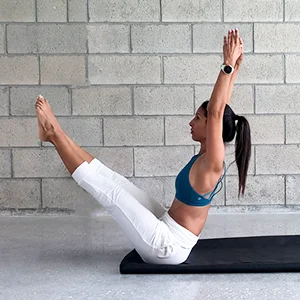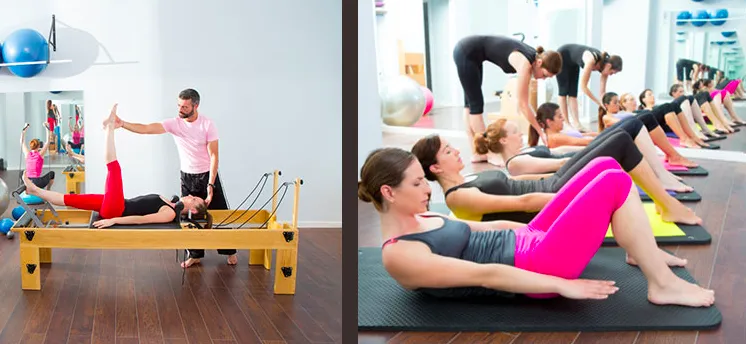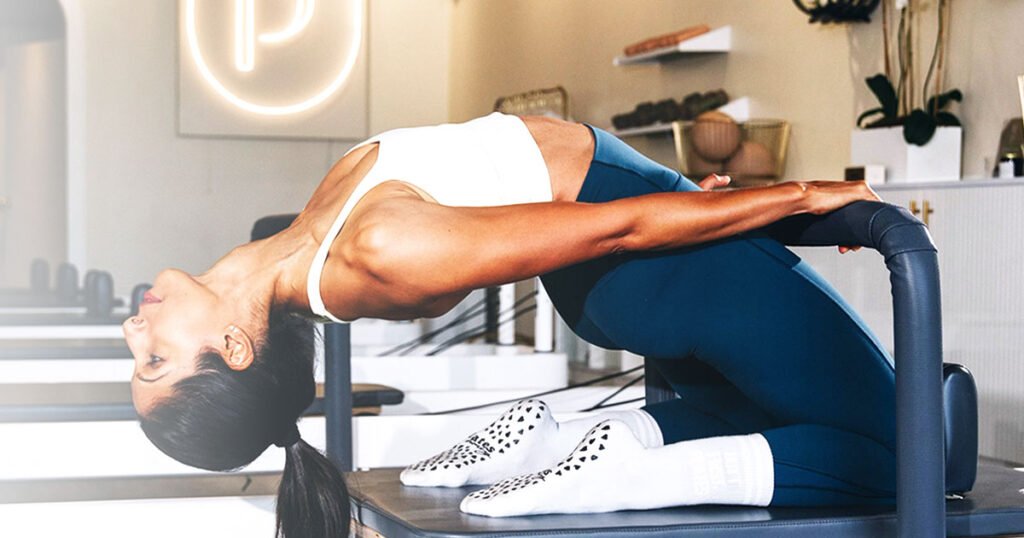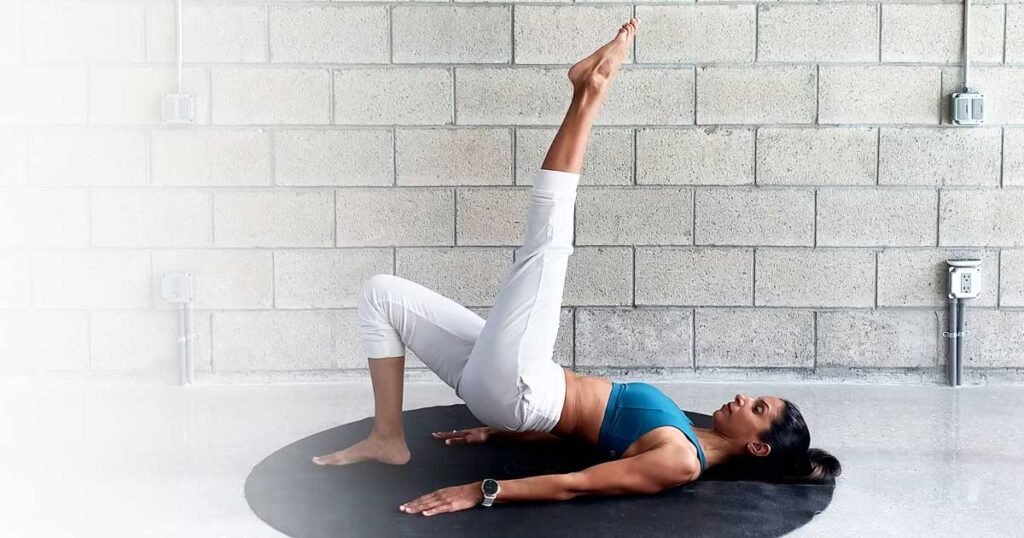Pilates studios are popping up, filled with great reformer classes. I often hear, ‘Which is better, reformer or mat?’ It’s like picking between chocolate and vanilla—I love both! Hard to answer on the fly, especially between classes. But for Pilates lovers wondering, here’s a detailed comparison of pilates reformer vs mat benefits.
Before we delve into the Pilates reformer vs mat debate, let’s lay down some foundational facts first…
Differences Between Pilates Reformer and Pilates Mat
In comparing ‘Pilates reformer vs mat’, it’s crucial to note their common origin with Joseph Pilates in the 20th century. They share core principles such as breathing, centering, concentration, control, precision, and flow. However, they differ significantly in terms of equipment use, types of exercises, accessibility, and overall experience.
So before jumping to conclusions about which is “better,” let’s examine each one’s uniqueness to grasp the differences.
What is Mat Pilates?
Mat Pilates uses a simple exercise mat and focuses on body weight and gravity resistance exercises. No fancy gear, just you, your mat, and a whole lotta core strength, flexibility, and balance work. Think the Hundred, the Roll-Up, the Teaser, and those Single Leg Stretches – you’re breaking a sweat without even standing up.
Here’s a concise comparison of the main differences in the ‘Pilates reformer vs mat’ debate:
1. Pilates Mat Equipment
As mentioned earlier, Mat Pilates is performed on a simple exercise mat without any specialized equipment. The focus is on using body weight and gravity to provide resistance. However, many pilates professional incorporate small props like pilates ring, resistance bands, ball, etc. to add more variety, resistance or support when needed.
2. Pilates Mat Exercises
Mat Pilates includes a series of exercises that focus on core strength, flexibility, balance, and overall body control. These exercises involve a combination of controlled movements, breathing techniques, and muscle engagement. The original mat Pilates consists of 34 fundamental exercises in different body positions, mainly focusing on the core muscles.
3. Pilates Mat Resistance
Since Mat Pilates relies solely on body weight for resistance, the exercises are often more challenging in terms of stability and control. The mat work can be very challenging, especially as you progress to the intermediate and advanced level exercises. Full body integration exercises like the “Teaser” and the fact that there is no machine to direct or support the body movement can be enough sometimes for you to feel a great muscular demand.
4. Pilates Mat Variety
Mat Pilates exercises can be quite diverse and can also be adapted to different fitness levels. Modifications are easily done by adjusting the angle of the body, using props, or incorporating variations. This diversity is also one of the reasons why mat Pilates classes can be so different from one teacher to another. You’ll notice many variations of exercises with a common emphasis on how to execute it; with control, precision, concentration, breathing and more.
5. Pilates Mat Accessibility
With just enough space for a mat you can practice pilates mat anywhere. It doesn’t require any specialized equipment other than the mat itself and maybe a few small props, making it convenient to practice at home or in group fitness classes.
6. Pilates Mat Cost
Mat Pilates doesn’t require specialized equipment, so it tends to be more cost-effective and budget-friendly. Most Pilates studios don’t offer mat classes, but look for those at big fitness clubs and community centers. You can also find many online classes. YouTube mat pilates classes is your free option.
Benefits of Mat Pilates
In general, Mat Pilates helps improve posture, balance, and alignment. It targets the deep stabilizing muscles of the core and promotes functional strength and flexibility, which can benefit daily activities and prevent injuries.
Since there’s no added equipment, you rely heavily on your core muscles to stabilize your body during exercises. This can greatly help you improve your core strength and stability.

What is Pilates Reformer?
The Pilates Reformer, featuring a sliding carriage, springs, straps, and attachments, offers adjustable resistance for diverse exercises. It’s highly favored for its versatility in targeting different muscle groups and enhancing Pilates workouts.
Here’s a breakdown of some of the main differences between mat pilates and reformer:
1. Pilates Reformer Equipment
The Pilates Reformer is a specialized piece of equipment that consists of a sliding carriage attached to springs, ropes, and pulleys. You can adjust the resistance to make exercises easier or more challenging. Although heavier springs mean more muscle load, it’s not always the case. In many exercises, especially core-focuses exercises – the lighter spring setting will challenge your stability and core much more!
2. Pilates Reformer Exercises
The Reformer allows for a wide range of exercises that target various muscle groups. The sliding carriage and adjustable resistance provide a unique challenge that enhances both strength and flexibility. The repertoire on the machines allows a full body workout against spring tension, with the body supported in many different positions, and with large range of motions.
3. Pilates Reformer Resistance
The Reformer’s design guides the practitioner through movements with more precision due to the sliding carriage and the resistance provided by the springs. The Reformer’s adjustable springs and pulleys provide variable resistance, making it possible to customize the intensity of each exercise. The level of intensity and muscle resistance can be relatively high on the Reformer.
4. Pilates Reformer Variety
The Reformer’s adjustable resistance allows for a broader range of exercises that can target muscles with varying levels of intensity. Its versatility is probably one the main reasons it became such a mainstream among fitness enthusiasts.
5. Pilates Reformer Accessibility
Reformer Pilates typically requires access to a specialized Pilates studio equipped with reformer machines. Due to the equipment involved, it’s often led by a trained instructor who can guide participants through the proper form and adjustments. You can also purchase your own Reformer for home use and hire a private pilates trainer or simply follow online classes.
6. Pilates Reformer Cost
If you decide to get your own Reformer equipment, it’s gonna cost ya, and it’s not exactly space-friendly. If you decide to visit a pilates studio and take a group class it will probably cost you between $20-50 per class. A private session will cost you more.
Benefits of Reformer Pilates
Just like on the mat, the Reformer engages the entire body, promoting strength, flexibility, coordination, and balance. Its springs provide assistance or resistance, fitting various fitness levels. This feature helps build muscle tone and endurance. For those recovering from injuries or with limitations, the Reformer’s guided exercises and support are beneficial.

So now back to the question…
Pilates Reformer or Mat? Which is Better?
Ultimately, there’s no one-size-fits-all answer to which form of Pilates is better. The choice between Mat Pilates and Reformer Pilates depends on your fitness goals, preferences, and access to equipment. Some people prefer the simplicity and accessibility of Mat Pilates, while others enjoy the added challenge and versatility of Reformer Pilates. Many individuals incorporate both forms into their fitness routines to reap the benefits of both.
Both forms of Pilates offer unique benefits and can complement each other in a well-rounded fitness routine. Mat Pilates focuses on body weight exercises performed on a mat, whereas Reformer Pilates uses specialized equipment to provide resistance and a wider variety of exercises.

A bunch of us Pilates pros, myself included, often suggest kicking things off with a few mat Pilates sessions. Sure, mat Pilates might not seem as exciting or tough as the Reformer at first glance, but trust me, it’s like a secret level-up trick for your Pilates journey. Starting on the mat gets you physically and mentally primed for the Reformer adventures ahead. But hey, don’t get it twisted – both mat and Reformer will give you a run for your money. Mastering the art of engaging your core muscles is key in the Pilates universe, and it’s usually a bit simpler to get the hang of this on the mat, where you’re not juggling the added challenge of managing a Pilates machine.
Is Mat Pilates harder than Reformer Pilates, or vice versa? It depends on your fitness level, preferences, and the exercises you choose. Both styles offer unique challenges suited to different fitness goals and abilities. Mat Pilates may seem tougher for some due to its emphasis on core strength without machine support. Conversely, the added resistance and variety of exercises on the Reformer might present a greater challenge for others.
So, there you have it – Pilates Mat vs. Pilates Reformer. Which one’s your jam? Whether you’re vibing with the mat or gliding on the Reformer, it’s about the core, balance, and the sculpted bod. Pick your poison or mix ‘n match – either way, you’re on your way to Pilates paradise! 😉



